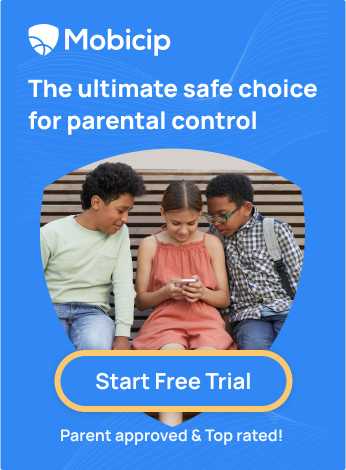Inside Kids’ Screens: Aug 2025 Trends from Mobicip
The August 2025 Screen Time Report from Mobicip provides insights into how children and teens are spending their screen time. From gaming and streaming to messaging and browsing, this month’s screen time report highlights the top apps by age group, giving parents a window into kids’ digital lives.
About This Report
Each month, Mobicip analyzes anonymized screen time data from thousands of families to uncover how children and teens are spending time on digital devices. From the most popular apps to platforms with the highest usage, this report offers actionable insights into current trends, age-specific behaviors, and emerging parental concerns. Our goal is to help families make informed decisions and support healthy digital habits for kids in an evolving tech landscape.
Average Screen Time by Age

The graph compares July data with the August data.
A closer look at the screen time report across different age groups shows that the shift from July to August was not uniform. Among the youngest children, screen use stayed mostly steady, with only minor changes.
Middle childhood (ages 6–10) showed a gentle rise, suggesting that digital activities became a bit more common during August, perhaps as part of both recreation and light academic preparation before school.
In early adolescence (ages 11–14), the increase in screen time was more noticeable. This period often brings greater social and academic use of devices, and the return-to-school season may have reinforced this trend.
By contrast, mid-to-late teens (ages 15–17) also saw growth, but it was more moderate, reflecting a balance between leisure and the increasing pull of schoolwork.
Interestingly, the oldest group in this dataset (around age 18) showed one of the sharper increases. This may point to a greater reliance on digital platforms for both academic preparation and social connection as they transition into more independent routines.
Overall, August brought a general rise in screen time, with the steepest increases occurring among pre-teens, younger teens, and those at the threshold of adulthood.
For parents, these patterns serve as a reminder that not all screen time is equal. Some of it may be genuinely helpful—supporting schoolwork, building friendships, or encouraging creativity—while some may lean more toward distraction. This is a good moment for families to check in: is the extra screen use helping kids adjust to new routines, or is it pulling them away from sleep, physical activity, or focus on school? Asking that question regularly can help strike the right balance.
Time Spent by Category

While we might expect screen time on social media to drop as kids head back to school, the data shows the opposite. Social media jumped from 31% in July to 36% in August, while entertainment and other activities dipped slightly. This could mean kids are leaning more on social media to stay connected with friends as school routines pick up again. Interestingly, gaming remained steady at 16%, showing that while homework and schedules may shift, gaming habits often hold firm.
For parents, this is a good moment to check in: Is social media becoming a healthy support for staying socially connected, or is it turning into a distraction from new academic routines? Even small shifts in percentages can hint at bigger changes in how kids balance their time when school is back in session.
Top Apps by Age Group

In August, kids and teens gravitated toward apps that blend entertainment, creativity, and connection. YouTube and TikTok topped the list because they cater to almost every age group with endless short videos and trending content. Younger children leaned toward Disney, Minecraft, Roblox, and YouTube Kids, showing a preference for safe spaces to play, watch, and explore. Tweens and teens favored Instagram, Snapchat, and Spotify, reflecting their growing interest in socializing, self-expression, and music discovery. Netflix bridged all ages with family shows and teen dramas.
But seriously, what was that five year old doing with ChatGPT, one wonders !
Parental Concerns – Most Blocked Apps
While kids often gravitate toward fun and trending apps, parents are keeping a close watch on the ones that raise red flags. The most frequently blocked apps reveal where families are drawing boundaries—whether due to safety risks, excessive screen time, or exposure to age-inappropriate content. The trend in August was this:
- TikTok and its related versions dominate the blocked list, including Musically, TikTok Lite, TikTok Studio, SaveTok, TikSave, and TokRepost, together reflecting concerns over addictive use, inappropriate content, and unmonitored sharing.
- Snapchat stands out with more than 700 total blocks, largely due to disappearing messages and location-sharing features.
- Likee and similar short-video communities are also heavily restricted, showing parents’ worries about viral, user-generated video platforms.
- Dating and hookup apps such as Tinder, MeetMe, and DOWN are frequently blocked, despite being age-restricted.
- Messaging apps like WhatsApp, Telegram, and Kik are blocked by many families, pointing to fears about private, unmonitored communication.
- Even mainstream platforms such as YouTube, Instagram, and Facebook appear on the list, showing that parents are taking a proactive approach to limiting screen time across popular apps.
Device Usage
Children are spending the most time on iOS devices, showing that iPhones and iPads continue to be their go-to choice for entertainment and learning. Android devices come next, still widely used but not quite as dominant. Windows laptops and computers follow, suggesting kids often switch to them for schoolwork or games. MacBooks and iMacs see less activity, indicating they’re less popular among younger users. Kindle devices rank the lowest, showing that while e-readers are still around, they’re far from being the main screen kids reach for.
Why Are Screen Time Reports Important?
Children’s digital habits shift as technology changes, and these patterns reveal where their time and attention go. Regular updates give parents a clearer view of how kids use devices and which platforms are most engaging. With this understanding, families can guide screen time toward more positive experiences, set boundaries that stick, and stay ahead of potential risks. We’ll keep sharing Screen Time Reports each month to help make screen use smarter and safer.

Related watch:
Video Vault: Safer Screen Time, Happier Families with Mobicip





